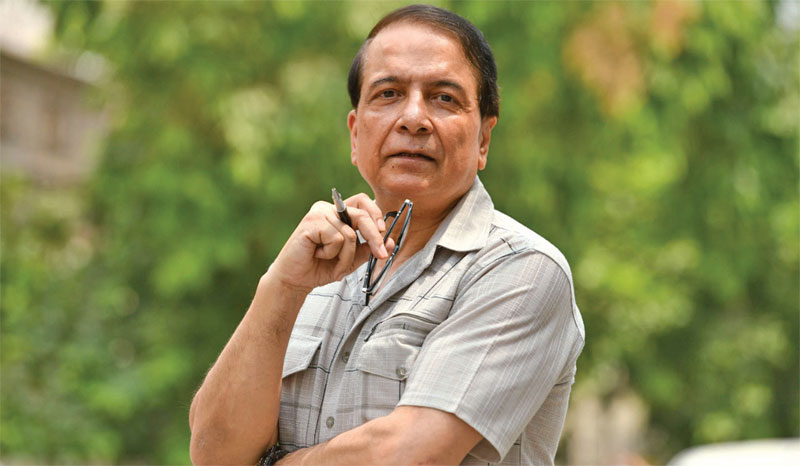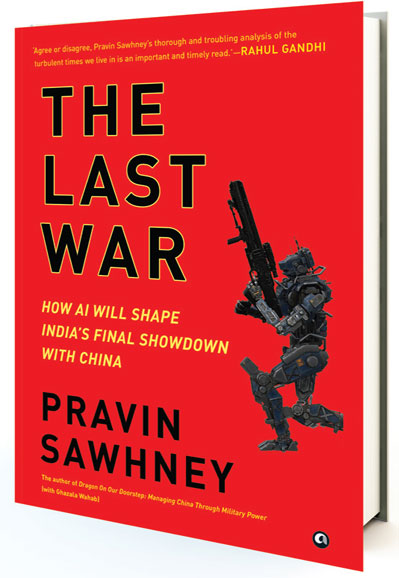Pravin Sawhney, author of The Last War: How AI Will Shape India’s Final Showdown With China

AI in warfare is an alien subject in India. How did you come upon this subject and why did you think it was important to write on it?
The term AI has been around a long time. In 2014, when the Pentagon announced its third offset strategy with focus on AI and autonomy to leapfrog the PLA’s growing capabilities in new war domains, I became aware that AI in warfare was round the corner. Since I was co-authoring the book Dragon on our Doorstep: Managing China Through Military Power in 2017, I decided to concentrate on PLA’s war domains. I knew that the subject of my next book would be the use of AI in PLA’s war domains.
China, after all, is not only India’s neighbour with close ties with Pakistan, but also has a long-disputed border with India. In my first book The Defence Makeover: Ten Myths That Shape India’s Image in 2000, I had argued that PLA’s fast growing boarder management was an immediate threat to India. I also wrote that the seeds of the future India-China war lay in the disputed eastern sector (Arunachal Pradesh) since this area was huge and India cannot barter away so much land for peace. I was proved right. After the ill-thought 1993 bilateral agreement which re-named the disputed border as the Line of Actual Control, PLA’s transgressions and intrusions became a regular feature. Thus, in Dragon on our Doorstep, I spoke of increased PLA threat from its new war domains. Writing on PLA’s use of AI in warfare was the next logical step.
 What was your search and learning process like? Were there moments of doubts where you felt you wouldn’t be able to do justice to the subject?
What was your search and learning process like? Were there moments of doubts where you felt you wouldn’t be able to do justice to the subject?
I started work on the present book in 2017. Google was a big help in finding me good books, monographs, video discussions, and articles mostly by US experts, on the subject. I was fortunate to be invited by PLA-supported Xiangshan Forum in Beijing in 2018. It had a session on ‘AI in warfare’ where I heard a Chinese industry executive. His talks had amazing clarity on PLA’s AI roadmap. This session spurred me to do expansive research on the subject.
The following year, I got luckier. Beijing Xiangshan Forum 2019 invited me as a speaker in the AI session where my talk was well received. This convinced me that my operational ideas (which I have elaborated in the book) on the new robotic warfare were doable. I don’t think I had moments of doubt on the subject. However, there were times when I felt that I needed to read and reflect more on certain issues, which I did.
One of the criticisms of the book has been that both the ideas and the threats projected in it are futuristic. How do you respond to that?
I do not agree with such criticisms. We must keep in mind that the technology we are faced with is software-driven and is thus evolving at a rapid pace. For example, in the ongoing Russia-Ukraine war, drones, while controlled by humans, have enough AI in them to identify targets and then decide on the best way to destroy them. The PLA has given special focus to drones in the air, ground (robots), and sea.
It is also working on AI in electronic warfare (cognitive AI), AI in cyber, AI in software, AI in decision-making (human-machine collaboration), and AI in all backdoor, logistics, and maintenance activities. Moreover, given the numerous advantages the PLA has over the technology-inferior Indian military (details in the book), it is well poised to achieve first mover advantage in a new war that the world has never seen. In this war there will be no ORBAT (order of battle). But it will be a whole-of-nation war enabled by AI.
You write that China would be ready for a war of occupation against India by 2023. Of course, that does not mean that it will go to war with India. However, in the time that you wrote the book and now, do you think that Indian foreign policy has made war imminent, or has it averted it?
My timeline of the PLA being ready for experimentation with the new warfare against India is doable and realistic. With capabilities in place, will China go to war? In my understanding of China, it will always choose peace and cooperation over combat with India. Provided, India does not cross its red lines, both political and military. Unfortunately, India, mindlessly is doing precisely that for three reasons: One, Indian government seems to have an irrepressible urge to project Prime Minister Modi as a strong nationalist leader. The foreign minister, S. Jaishankar is at the forefront of declaring that India is prepared for competition with China, which given the two nation’s national power, is a ludicrous proposition.
Two, Indian military leaders are dangerously unaware of PLA’s capabilities and capacities. Living in a bubble, they believe there will be no full-scale war and that they will be able to hold both the PLA and Pakistan military simultaneously. And three, India has chosen to be a part of US’ military strategy for Indo-Pacific region which China believes is meant to curtail its Belt and Road; this is China’s red line. China has repeatedly said that QUAD (grouping of India, US, Japan, and Australia) is meant to contain it. In my opinion, India will continue to provoke China and do advanced military exercises with QUAD members. Given this, India’s current China policy will lead to war.
Senior Indian veterans have been talking about lessons from the Russia-Ukraine conflict. According to you, what are the lessons that the Indian military needs to learn and unlearn from that conflict?
The Russia-Ukraine war is between major powers. While Ukraine is the battlespace, the opposing sides are Russia and Nato (where US military is the prominent component) by proxy. Wars between major powers will be protracted since neither side will be able to exercise war control and hence be confident of achieving its objectives for which it entered the war. Thus, in case of major powers, peace will be accomplished not on the battlespace, but on the negotiating table.
So, why did Russia start the war? Because it was faced by existential threat on its border. After eight years of seeking peace since the 2014 Minsk agreement, Russia saw that its red line was being crossed. Moreover, from the recent statements by French President Emmanuel Macron and former German Chancellor Angela Merkel, it appears that from the US’s perspective, the Minsk agreements were meant to buy time for war preparedness against Russia.
There are two lessons for India. One, don’t cross the red line of a major power, in this case China. The Indian government is unable to understand the reality that the US is using India to weaken China just as it has been using Nato, Ukraine, and the European Union to weaken Russia.
And two, the war between Indian military (medium power) and China (major power) will be swift, intense, and decisive where the PLA will exercise total war control. Indian army chief, Gen. Manoj Pande is wrong in saying that a lesson of the Russian-Ukraine conflict is that state wars will be protracted. He is advised to consider the huge gap between the military power of Indian military and the PLA.
Military power has four components: technology; war concepts (how war is to be fought to optimise present capabilities); capacity (indigenous production of war materiel); and political determination (remember Modi’s 19 June 2020 statement that PLA has not entered Indian territory. This amounted to losing the war at the highest level even before combat started). India lags dangerously behind China in all four components.
Is The Last War the final word on warfare as of now or are you considering a follow-up to that?
There are options that I am considering, including a doable roadmap for capability-building for the Indian military. But it is too early to talk about it.

